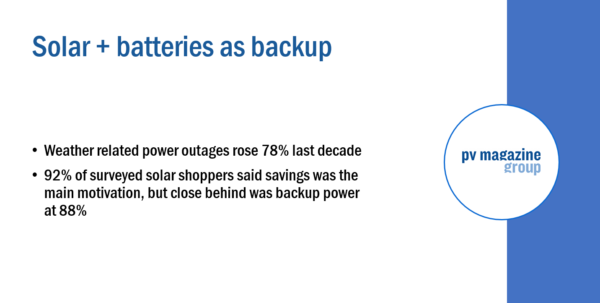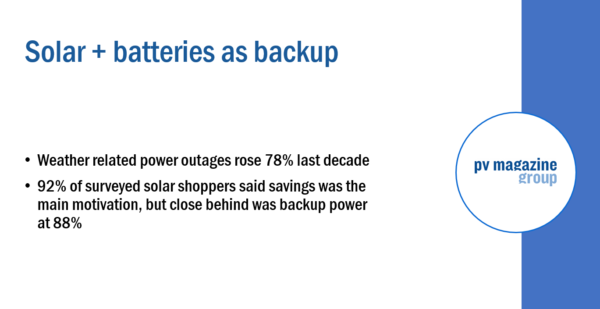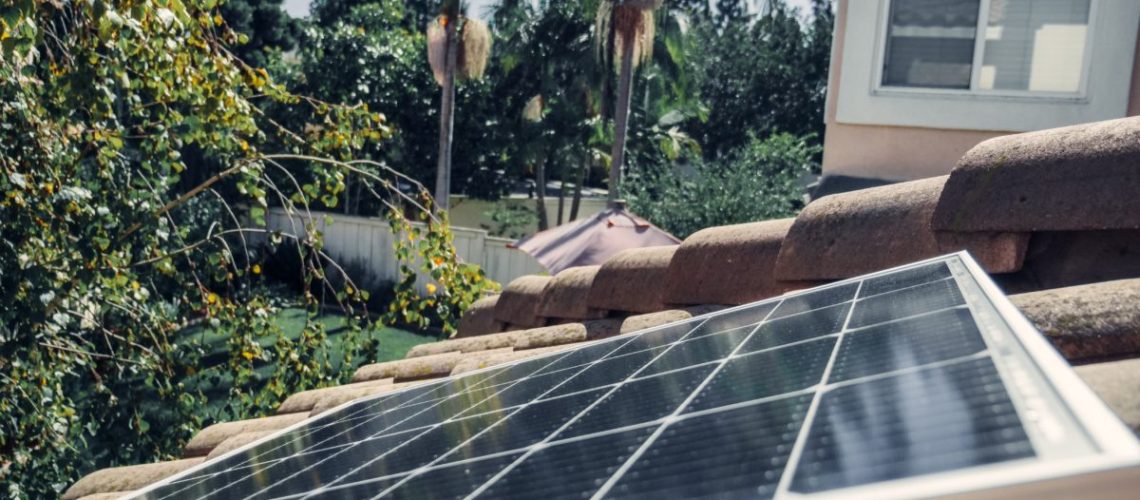Rooftop solar is considered an important part of the evolution of our grid. It requires less transmission buildout than traditional, centralized power generation, is more resilient in events that disrupt the grid, and saves land. Analysis by Environment California found that, based on a state regulator estimated deployment of 28.5 GW of solar through 2045, rooftop solar could prevent the development of 148,000 acres of land versus a centralized utility-scale-only model. That is an area about half the size of Los Angeles that could be preserved.
NEM has enabled 1.3 million customers to install roughly 10 GW of customer-sited renewable generation. NEM systems reduce the demand on the electric grid by as much as 25 percent during midday when the sun is shining, said the California Public Utilities Commission.
Across the county, we’ve been witness to policy battles in California, Florida, Indiana, Idaho, Michigan, and North Carolina. California represents roughly 50% of the U.S. residential solar market. This market is set to undergo a major change as the California Public Utilities Commission adopted Net Energy Metering 3.0 this past December. As is often the case in the tech world, the U.S. will be watching California’s response to the rollout of NEM 3.0 as an indicator for how their state’s respective utility commissions will adopt rulemaking changes and how its market participants pivot around new rules.
There is no denying that sharply cutting net metering export rates presents a challenge for distributed solar installers. ROTH Capital Partners projected that residential solar demand may fall 30% in 2023 following the adoption of Net Energy Metering 3.0 in California. NEM 3.0 moves from the current retail time-of-use based rates to a far lower rate based on the “avoided cost calculator”.
This new rate, which is on average 75% lower than the legacy rate, is designed to avoid the “cost shift”, in which non-solar owners cross-subsidize solar owners. While this cross-subsidization has been proven to exist, there is some disagreement between third-party analyses by national laboratories and internal utility commission analysis on exactly how much cost rooftop solar owners are shifting onto their neighbors. Regardless, the rulemaking decision has been made, and NEM 3.0 will take effect on April 15 this year.
Trade organizations like the Solar Energy Industries Association and the California Solar and Storage Association (CALSSA) called for a more gradual phase-down of net metering credit values, giving the industry time to adapt their products and services to offer a clear benefit to their customers. However, rates are going to be a fraction of what they were, essentially changing overnight. In 2017, when Nevada cut its rates by a similar amount and tacked on a $35 fixed charge to solar customers, it led to a 90% drop in residential solar adoption. To make matters more complicated, the Avoided Cost Calculator can be revised on an annual basis, and it will likely be the target of intense scrutiny and litigation by the distributed solar sector and its advocates.
This kind of regulatory environment whiplash is a heavy burden on installers as it places a lot of doubt in consumer evaluation of the benefits of solar. As a former residential solar salesperson, this author can personally attest to the difficulty of offering an attractive customer value proposition when there is so much uncertainty. The piecemeal fashion of federal and state incentive adjustments made it difficult for my customers to confidently make a decision to move forward. This is one of the reasons the solar and storage industry rejoiced when the Inflation Reduction Act extended the 30% Investment Tax Credit for the next decade, as it created certainty for the long-term.
(Read: “California cuts rooftop solar net metering: An industry reacts“)
What options remain for prospective residential solar customers when NEM 3.0 takes over? And how does a residential solar installer win in this new environment?

Customer expectations for the benefits of rooftop solar will need to be reset. EnergySage said the payback period under NEM 3.0 will shift closer to 9 to 10 years, up from today’s average of about 5 to 6 years. It said that customer savings will be roughly 60% less than what they were under NEM 2.0.
As such, installers will be selling as many NEM 2.0 systems as they can before the sunset date of April 14, 2023. By then customers must submit a complete interconnection application, a signed contract, and a single-line diagram, to be grandfathered in for the next 20 years. This could prove difficult for installers as ongoing supply chain constraints may push out installation dates for months as they try to source components.
Installers will have to work hard to establish strong partnerships with component suppliers and to set transparent customer expectations that projects may face long delays as a glut of applications come in. Systems must be fully installed and connected to the grid by April 14, 2026, to retain NEM 2.0 status.

Those who adopt solar after the sunset date will be faced with a new set of options under NEM 3.0. Dr. Ahmad Faruqui, a grid controls expert, economist-at-large, and California rooftop solar owner, addressed this question in a case study published in <b>pv magazine</b>, which can be read by scanning the QR code onscreen. Dr. Faruqui sees three main options for residential solar customers in California:
- Install the same size system they would have installed under NEM 2.0 but pair them with two batteries. In Dr. Faruqui’s example, the customer installs an 8 kW system, which will produce 10,000 kWh to net out annual electricity usage, but installs another 9.8 kWh battery to absorb the excess generation in the afternoon. While this prevents net-metered losses, it also increases the overall price for the system considerably.
- Undersize their PV systems to prevent exports from taking place and end up with an annual deficit. In Dr. Faruqui’s case, that would mean the customer would just install a 4 kWh system and have an annual deficit of 5,000 kWh. The customer would pay PG&E directly for the difference at rates that are projected to rise at least another 30% by 2026. While this offers some savings, it falls short of many customer expectations to cover as much of their usage with local rooftop solar as possible.
- “Cut the cord” and construct their own microgrid using a bi-directional EV charger and to install a small backup generator that might run for a total of 50 hours a year. Of course, this route carries its own risks and for the foreseeable future, will only interest wealthy customers.
While these options can represent marginal savings to customers, Dr. Faruqui is skeptical that rooftop solar will continue to flourish as it had before.
In the pv magazine Op-Ed article, he wrote,
“The only thing I can think of that will validate that assertion is that rooftop solar installations, either with or without batteries, will plummet and thus the so-called cost shift from the poor to the rich will diminish. Maybe that’s the real intent of the unanimous decision. But what will also diminish is California’s pursuit of net zero carbon emissions.Telling consumers that large-scale solar costs only 4 cents/kWh rings hollow when they are paying 30 cents/kWh. In the coming decade, electricity rates will continue to rise in the billions of dollars, as stated by the utilities. They won’t be able to blame NEM for the rate increases. However, the one option consumers have today for lowering bills while staying connected will be taken away by this unanimous decision. This will also represent a setback for the state’s electrification goals. What’s the primary reason that heat pump installations are rare in California? The high cost of electricity mentioned above. Heat pumps become cost-effective when customers have installed rooftop solar panels. The same can be said for EVs.” Ahmad Faruqui, economist-at-large.
Under the new net metering rule, systems paired with batteries are expected to have the same payback period as standalone systems. As such, California’s solar installers will look to to add battery energy storage to their offerings to remain competitive.
One of the main benefits of storage that is increasingly attractive to customers across the US is backup power during grid outages. Nonprofit organization Climate Central reports that weather-related power outages in the U.S. increased by 78% from 2011 to 2021 over the ten years preceding it. An aging grid and increased extreme weather continue to push this number higher.

A SunPower survey of prospective solar customers found that over 92% of respondents cited energy bill relief as the main motivation for adopting solar, but this benefit was followed closely by the desire for resiliency in power outages. Over 88% of respondents said backup power during outages was a main motivator for shopping for solar. Installers will likely look to abandon sales pitches focused purely on savings and instead will need to frame solar and battery energy storage as an improved service over traditional grid-provided energy.
A market focused on backup power and self-consumption only limits the true power of distributed energy, though. Battery energy storage paired with distributed rooftop solar presents a handful of emergent revenue streams that can improve value for both the homeowner and the installer. Grid services, battery aggregation, demand response and peak demand shaving, and virtual power plant services are all being adopted and tested, often with promising results.
Take a study by the University of Otago in New Zealand for example. In the study, researchers operated grid-connected connected solar-powered batteries over several neighborhoods and aggregated them in a demand-response export system. The researchers found that the collective use of batteries had dramatic effects on both load smoothing and peak demand shaving. Aggregation of smart storage led to a reduction in per-house battery requirements by 50% for load-smoothing needs and by 90% for peak shaving. This is a clear example of how solar plus storage can be a benefit for California’s evolving needs.
Residential installer Sunrun has been a pioneer in aggregating batteries in the U.S. In 2019, the residential installer secured a 20 MW bid to participate in New England’s ISO 2022-2023 forward capacity market, one of the first contracts of this type in the United States.
As part of the bid, Sunrun said it would deploy distributed solar and battery storage to about 5,000 customers in Massachusetts. It will be required to offer the grid 20 MW of power, 24 hours a day for the one-year period. In return, Sunrun will be paid $3.80/kW/month, representing a $912,000 total contract value. Homeowners who signed up for the program agree to allow their battery to be discharged overnight. In exchange, they receive an upfront cash incentive as either a payment or a reduction in the upfront cost of their system. This month, Sunrun announced it partnered with Lunar Energy to expand its battery aggregation and virtual power plant business.
A VPP can reach past solar and storage, as well. Jigar Shah, director of the U.S. Department of Energy Loan Programs Office, wrote about VPPs in a recent issue of pv magazine. He said,
“A VPP is a virtual aggregation of distributed energy resources like PV, energy storage, EV chargers and demand-responsive devices (such as water heaters, thermostats, and appliances). VPPs do more than provide decarbonization and grid services – they increasingly give grid operators a large-scale and utility-grade alternative to new generation and system buildout through automated efficiency, capacity support, and non-wire alternatives. By deploying grid assets more efficiently, an aggregation of distributed resources lowers the cost of power for everybody, especially VPP participants.”
Shah said that the growth of VPP is held back not by technological innovation, but lack of debt financing for unfamiliar technologies, and the ability of innovative grid-scale solutions to tap into viable business models.
VPP’s have shown promise for serving renters, too. PearlX, self-described as a flexible energy provider, recently announced the launch of a multi-family virtual power plant (VPP) service in California.
“Project Flexifornia” is a solar and storage VPP for California renters, initially targeted for a set of 1,400 apartments across five communities in Southern California Edison (SCE) and Pacific Gas and Electric (PG&E) territories. The new VPP service follows the company’s implementation of a VPP multi-family project in Texas earlier this year.

Under the program, tenants will gain access to solar, storage, and electrification services on-site, including smart thermostats and EV charging. PearlX said renters will receive a 5% to 10% discount on electricity bills at no cost. Renters will also have the benefit of backup power via battery energy storage during grid blackouts.
The company said the platform addresses multi-family renters of all incomes. Low-income with past credit issues can access the service via a custom “non-credit” underwriting process. Property owners who participate will hold a cash-yielding asset at their housing community at no cost to them, actualized through annual lease payments from PearlX.
“In September 2020, FERC Order 2222 opened the door for VPPs in the United States. Nearly two years later, VPPs are just beginning to compete in organized capacity, energy, and ancillary services markets at a meaningful scale at the regional level. To truly unlock VPP’s potential, wide reaching deployment at the national scale is needed,” concluded Jigar Shah in his Op-ed.
The rollout of NEM 3.0 and similar net metering cuts nationwide creates a hurdle for residential and commercial installers, but the larger market and policy environment should offer some wind in their sails.
In addition to the emergent possibilities unlocked by energy storage and VPPs, we are only six months removed from the Inflation Reduction Act, which set aside a record $369 billion for climate and energy spending. Over $60 billion in private funds have been announced in the six months since the landmark law passed. Just this week, the Internal Revenue Service released guidance on qualifiers for making the most of its rich set of tax credits, which serve everything from upstream to downstream, manufacturing and installation, jobs and workforce training, serving disadvantaged energy communities, and more.
In his recent State of the Union address, President Joe Biden shared that over 100,000 clean energy jobs have been created in the short time since the IRA was passed. Jason Grumet, chief executive officer of the American Clean Power Association said that number will reach over one million US jobs over the next several years.
Abigail Ross Hopper, chief executive of the Solar Energy Industries Association (SEIA) said, “By 2032, there will be five times the amount of solar that’s installed today, which is enough electricity to power every home east of the Mississippi River. People in every zip code will be breathing cleaner air and working in stable, family-supporting clean energy careers.”
Analysis by Princeton University said investment in solar could reach $321 billion in 2030, nearly double the figure of $177 billion expected under the previous policy landscape. The Act may lead to nearly $3.5 trillion in cumulative capital investment in new American energy supply through the next decade.



